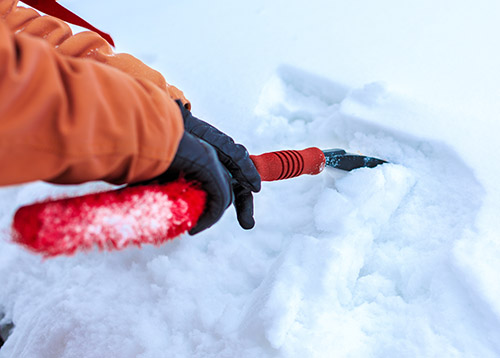| EN 511 Explained18 October 2018 | Alex Working in cold conditions can have a detrimental effect on you, and problems can include your productivity going downwards, your hands becoming sore, or frostbite starting to niggle at your fingers. The effects from the cold are different depending on your workplace. If you work in construction you'll want to keep your hands warm for when you're handling goods, but if you work in a freezer you'll probably want to protect against your fingers starting to freeze.
We have a wide choice of cold-resistant gloves here at Workwear.co.uk, but just being called cold-resistant doesn't help you understand what gloves are suitable for which job. This is why all of our cold-resistant gloves are tested to EN 511, a European Regulatory Standard designed to certify and measure a gloves resistance to the cold. The EN 511 score is four numbers long and appears on the back of most cold-resistant gloves and in their listings on our website, however if you're a little stuck, this short guide explains exactly what EN 511 is and how to understand it. What is EN 511?EN 511 will appear on most of our Cold-Resistant Gloves and will often appear on the back of the gloves and will always appear in the listing of the gloves on our website. The test will present itself with three different scores each one presenting that gloves score to a specific test. The three tests are; Convective Cold Resistance, Contact Cold Resistance and Permeability to Water. The first two scores will be rated between 0 and 4, and the last score (which tests the gloves ability to resist water) is a binary option and can only achieve a 0 or a 1. This article will now explain each score in detail, but remember if you are unsure of if some scores relate to EN 511, then simply look out for this symbol: Convective Cold TestThe first test finds out how well a glove resists the transfer of the cold by convection. Performance level 4 means that it has the most resistance, and level 0 means that it has failed. To test this, a glove is placed in a cold environment, placed on a heated hand and measurements are taken that discover how much electricity is needed in the hand to keep the hand warm. The more electrical power that is required, the lower the thermal insulation of the glove. Similarly, if not much electrical power is required, then the glove has stronger resistance to convective cold. A breakdown of each level is shown in this table:
Contact Cold TestContact cold resistance is measured by placing a glove between two metal plates at different temperatures and after a certain amount of time measurements are taken as to how big of a temperature drop has occurred. As with the convective cold test the ratings go from 0 to 4, with 0 a fail and 4 a pass. The ratings are measured by the following boundaries:
Water Permeability TestHow dry your hand will stay in wet conditions is measured by the Water Permeability Test. It's far simpler than the previous two, as it simply involves placing a glove in water for 30 minutes. If it resists the water after 30 minutes it achieves a level 1, and if it doesn't it fails and gets a 0. EN 511 in PracticeTo make things a little easier, let's have a look at an example. The Ejendals Tegera 297 Thinsulate Waterproof Gloves are a good choice because they offer good all-round resistance to the cold. They also feature a snowflake on the back of the hand, which demonstrates that some cold-resistant gloves will identify their resistance in another way than just showing their score. The Tegera 297 Gloves achieved an EN 511 score of 120 which means that they provide an okay resistance to convective cold, a pretty strong level of resistance to cold when in contact with materials. They also fail the water permeability test, meaning that they won't keep your hands dry if it starts to rain. Their results in the table on the listing look like this:
Still Unclear?All of the different standards and regulations can be difficult to get your head around, so if you're still a little unsure then why not leave a comment below where one of our support team will be happy to help. If you're ready to browse, we have a wide choice of Cold-Resistant Gloves on our website, all chosen by experts for cold weather work. |








